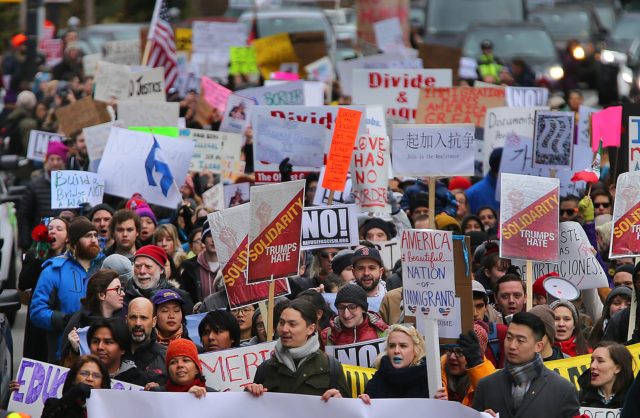Editor’s Note: Of all the public policy issues facing the United States today, immigration evokes the most tangled emotions: who to let in, how many, what skills, what countries? Immigration is too big for a single article, so we are pleased to bring three outstanding thinkers on three disparate – but related – parts of the immigration debate.
An Immigration-Reform Plan for the Age of Trump
by Ramesh Ponnuru
Lindsey Graham, the Republican senator from South Carolina, hasn’t given up on immigration reform. He was in the Senate to watch comprehensive bills he favored fall apart in 2006, 2007, and 2013. He was one of the presidential candidates whom Donald Trump beat for the Republican nomination in 2016. Trump won that contest after saying he would deport all illegal immigrants over a two-year period.
But Trump softened on the issue after winning the nomination, and Graham now thinks he can work with him to achieve many of the aims of those earlier bills. He isn’t trying to revive comprehensive legislation one more time, but he also rejects the idea of tackling issues a la carte. If Republicans try to enact legislation that only increases enforcement of the immigration laws, he believes Democrats will block it.
Instead, he tells me, he favors a series of discrete deals.
The first one would combine ramped-up enforcement, starting with “the bad dudes,” and the legalization of illegal immigrants who came here as minors. Republicans are open to that legalization, he said, and it “would be hard for Democrats to say no to securing the border and helping these 800,000 kids have a better life.”
The second one would legalize adult illegal immigrants working in agriculture and tourism, and at the same time require employers to use the e-verify program to make sure all new hires are legal workers.
Third, Graham would legalize those remaining illegal immigrants who passed a background check and paid a fine. In return he wants to shift legal immigration toward recruiting people with high skills rather than reuniting extended families. “The immigration system of the future would be merit-based,” he says.
I opposed the previous bills that Graham supported, and I’m not completely sold on this plan. But it has enough attractive elements to make me think that those of us who are more hawkish than Graham on immigration should consider it.
The earlier bills would have substantially increased immigration, and low-skilled immigrants would have made up much of the increase. Most Americans don’t want that, and the economic case for it is weak. His current idea would not raise immigration levels.
Under earlier versions of comprehensive reform, illegal immigrants might have gotten legal status before effective enforcement measures were in place – because, for example, those measures were tied up in court. In that case, legalization could have acted as a magnet for more illegal immigration, and we would remain stuck in a cycle of illegal immigration and amnesty. This three-step sequence would reduce this risk, because Congress would enact most of the legalization after enforcement had been implemented.
One reason advocates for illegal immigrants have opposed enforcement-first bills is that they have feared that Republicans would never get around to addressing their concerns once they got those bills enacted. Because Graham’s first step would include the legalization of illegal immigrants who came here as minors, though, it might be taken as a sign of good faith.
As leery as congressmen are about trying to address immigration again, Graham believes that the expiration of President Barack Obama’s executive order granting quasi-legal status to illegal immigrants who came here as minors will be a “tripwire” forcing action. Republicans don’t want Trump to renew their status – they said it was an abuse of power when Obama granted it – but fear the political consequences of exposing them to deportation again. So they have an incentive to pass legislation granting legal status, but they will want to get something to make that legislation more congenial to conservatives.
The senator thinks he has one more thing going for him: the president. “Here’s the key: Trump can do something no other Republican can do on immigration,” Graham said. What Trump can do is persuade the voters who are most concerned about illegal immigration that he is enforcing the law, and serious about making sure it is enforced in the future.
The fact that comprehensive reform got as far as it did in the past, Graham added, suggests that congressional majorities could be assembled for many of its components. All in all, he is more hopeful than most observers that a productive immigration compromise, or series of compromises, can be reached. For that to happen, many of the Republicans who blocked previous bills would have to come along.
What are the prospects of that? Graham’s judgment: “I believe the party will follow Trump if he leads.”
Ramesh Ponnuru is a senior editor for National Review magazine. Used with permission of Bloomberg L.P. Copyright ©2017. All rights reserved.
What Can the Declaration of Independence Teach Us About Immigration?
by David Azerrad
Debates about immigration usually center on two interrelated questions: on what basis should we decide whom to let into our country and what should we expect of immigrants once they arrive in America? Among our elites, the dominant view seems to be that we should not discriminate based on country of origin, nor should we demand immigrants assimilate to our way of life. Multiculturalism teaches that all cultures are equal (except our own, of course, which has caused so much harm to others) and that there is strength in diversity.
If applied consistently, such an approach to immigration would, in the long run, dissolve the national ties that bind us into one people. In response, some argue that America is a white, Christian nation and that our immigration policy should not dilute its essential character. To defend their point, they like to cite John Jay’s description in Federalist 2 of Americans as “a people descended from the same ancestors, speaking the same language, professing the same religion.”
Setting aside the fact that Jay made the colonists out to be much more unified and homogenous than they actually were, this approach to immigration does not sit well with most Americans and does not find support in our founding documents. Nowhere in the Declaration of Independence, or in the Constitution for that matter, are people classified according to race or religion (or any other of the categories that define contemporary identity politics).
The Declaration of Independence, it is true, does not address the question of immigration (with the exception of the seventh grievance leveled against the King) and cannot give us precise policy prescriptions. It can, however, help us think more clearly about immigration because it articulates certain fundamental truths we seem to have forgotten.
The first is that governments exist to secure the rights of their own people – not those of the rest of mankind. The Declaration does not begin with the self-evident truth of human equality, but with “one people” assuming its separate and equal station in the world. Mankind, we first learn, is divided into various peoples and “Powers of the Earth.”
People set up governments to ensure “their Safety and Happiness” and provide “for their future security.” Immigration policy, like all other policy, should therefore serve the interests and well-being of the American people. One should not confuse the universal duty not to infringe upon the rights of man with the duty of each government to secure the rights of its people only.
There are times when we may deem it best to encourage the migration of foreigners hither (as the colonists tried to do). But circumstances change. As a sovereign political community, we are always free to enact whatever immigration measures we deem to be in our national interest.
We could, for instance, decide at any given moment to completely block off all immigration. While one could argue against the wisdom of such a measure, it could not be said to be unjust. No one has a right to immigrate to America or to become an American.
To state the matter even more bluntly, we may discriminate as we see fit in matters of immigration. It is true that we believe all men to be created equal and therefore recognize that anyone can in principle immigrate to our country and become a part of our people. In practice, though, we are not blind to the fact that our common humanity is shaped by the laws, mores, traditions, and religious beliefs of particular nations. The rights of man are refracted through the dense medium of the regime.
The various “Systems of Government” form the minds and characters of people in very different ways. Not all ways of life are therefore equally compatible with ours. The Declaration, for example, distinguishes a “civilized nation” like Great Britain from “the merciless Indian Savages whose known Rule of Warfare, is an undistinguished Destruction, of all Ages, Sexes and Conditions.” While we today object to this characterization of Native Americans, we still are horrified by those, like ISIS, who eschew the rules of civilized warfare.
Although the Declaration does not contain a typology of regimes, it does reveal some of the important characteristics of ours. The list of grievances teaches that we are a people accustomed to representative government who think “the right of representation in the legislature … inestimable.” We expect the judiciary to be independent, the military to be subordinated to civil power, and we know “the benefits of trial by jury.” We jealously guard our rights and oppose “with manly Firmness” any encroachment upon them.
In sum, we are “a free people,” whose character had been shaped over the centuries by “the free system of English laws.” The Declaration suggests we should look for similar attributes in potential immigrants so that they may more readily become “one people” with us upon arrival. Our dedication to the proposition that all men are created equal should therefore not blind us to the fact that these same men, because of the diversity of political regimes and the power of deeply ingrained habits, are not all equally prepared to live as free men.
David Azerrad, Ph.D, is Director of the Center for Principles and Politics at the Heritage Foundation. Reprenited with permission of The University Bookman.
What to Do About Second-Generation Terrorists?
by Michael Barone
The terrorist (I’m not using names here) who rammed his car into pedestrians on Westminster Bridge and ran it through the fence around the Houses of Parliament turns out to be a son of immigrants and was born in England: a second-generation terrorist. He’s not the only one: second-generation terrorists include, according to an interesting analysis by Stephen Dinan in the Washington Times, the June 2016 Orlando Pulse nightclub murderer, the son of immigrants from Pakistan, one of the December 2015 San Bernardino shooters, the son of immigrants from Pakistan; one of the attackers in a May 2015 Garland, Texas, Muhammad cartoon drawing contest, the son of immigrants from Pakistan; the November 2009 Fort Hood assailant (classified as a perpetrator of “workplace violence” by the Obama administration), the son of Palestinian immigrants; the two terrorist bombers at the April 2013 Boston Marathon bombing, the sons of asylum seekers from the Chechnya province of Russia.
Opponents of restrictions on numbers of immigrants, refugees and asylum seekers from predominantly Muslim countries frequently make the argument that such restrictions wouldn’t have kept these second-generation terrorists out of the nations where they committed their terrorist acts. That’s true. But it’s also true that if such restrictions had been applied to their parents when they sought to immigrate or sought refugee or asylum status, the second-generation terrorists wouldn’t be here either. This doesn’t settle the debate over whether we should block entry to people from countries where Islamist terrorism is common or to people from such countries who cannot be vetted. You can make serious arguments on both sides. But the phenomenon of frequent second-generation terrorism is something to weigh in the balance.
And it does seem to be a phenomenon, not just a series of unrelated anecdotes. Dinan provides a thoughtful overview from former NSA and CIA Director Michael Hayden: “Historically, the ’high stress’ generation for American immigrants has been second generation. Mom and Pop can rely on the culture of where they came from. Their grandchildren will be (more or less) thoroughly American. The generation in between, though, is anchored neither in the old or in the new. They often are searching for self or identity beyond self.”
Those leaders who have declined to identify Islamist jihadism as a motivation for terrorism seem to be operating on two assumptions, (a) that the American (or British) people will retaliate with mass violence against perceived Muslims and (b) that seeming to blame Islam will antagonize Muslims here and abroad and motivate them to be terrorists. My guess is that the number of people moved to support terrorism in line with concern (b) is very small, but I’m not sure and will put that issue to the side. But I’m absolutely sure that concern (a) represents a view of the American people so factually wrong as to amount to group libel. It sees the American people as a dim beast easily provoked to hateful rage. I think it’s quite obvious to the vast bulk of the American people that most recent acts of terrorism here and abroad are committed by Muslims and that most, the vast majority, of Muslims in this country and in the world do not commit or support the commission of such acts. It’s actually not too hard to keep these two ideas in your head at the same time: it just requires modest powers of observation.
And I think the same common sense that allows most people to understand these two things also allows them to understand that while the first generation of Muslim immigrants, refugees and asylum seekers may not commit many acts of terrorism, their sons and daughters – the second generation – may do so more frequently. It’s not clear what policy you might advocate in response: perhaps just stronger programs of assimilation than many in our current university and media elites find congenial. But it’s something you may want to keep in mind.
Michael Barone is the senior political analyst for the Washington Examiner, a resident fellow at the American Enterprise Institute. This article previousedly appeared in the Washington Examiner.






